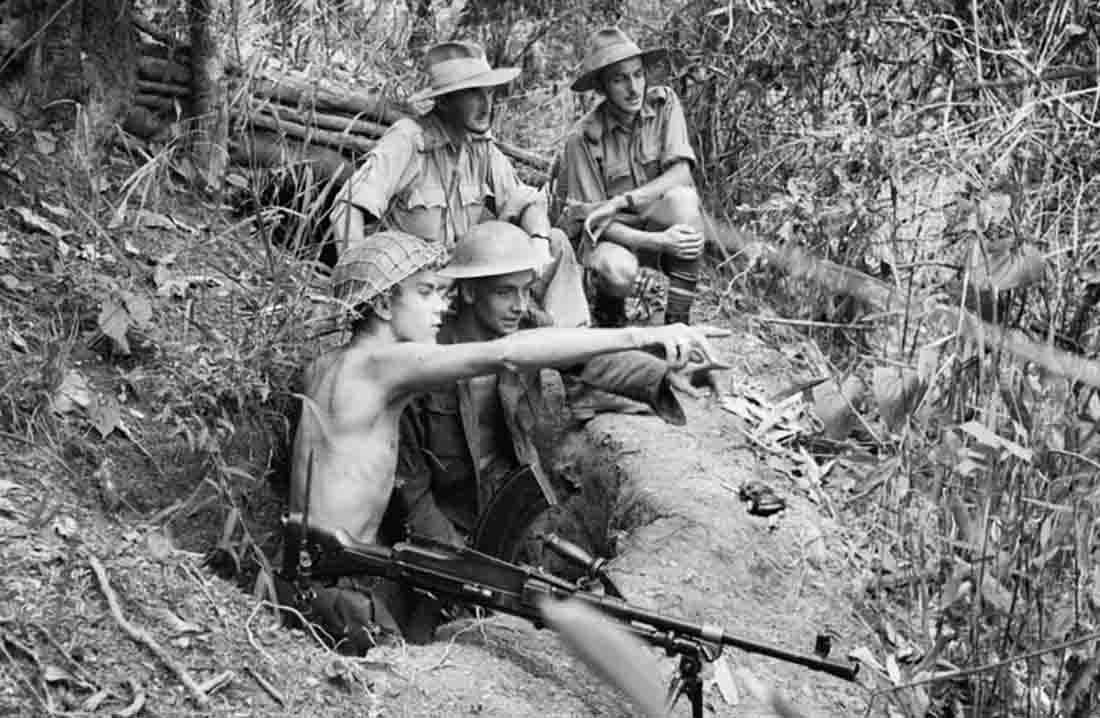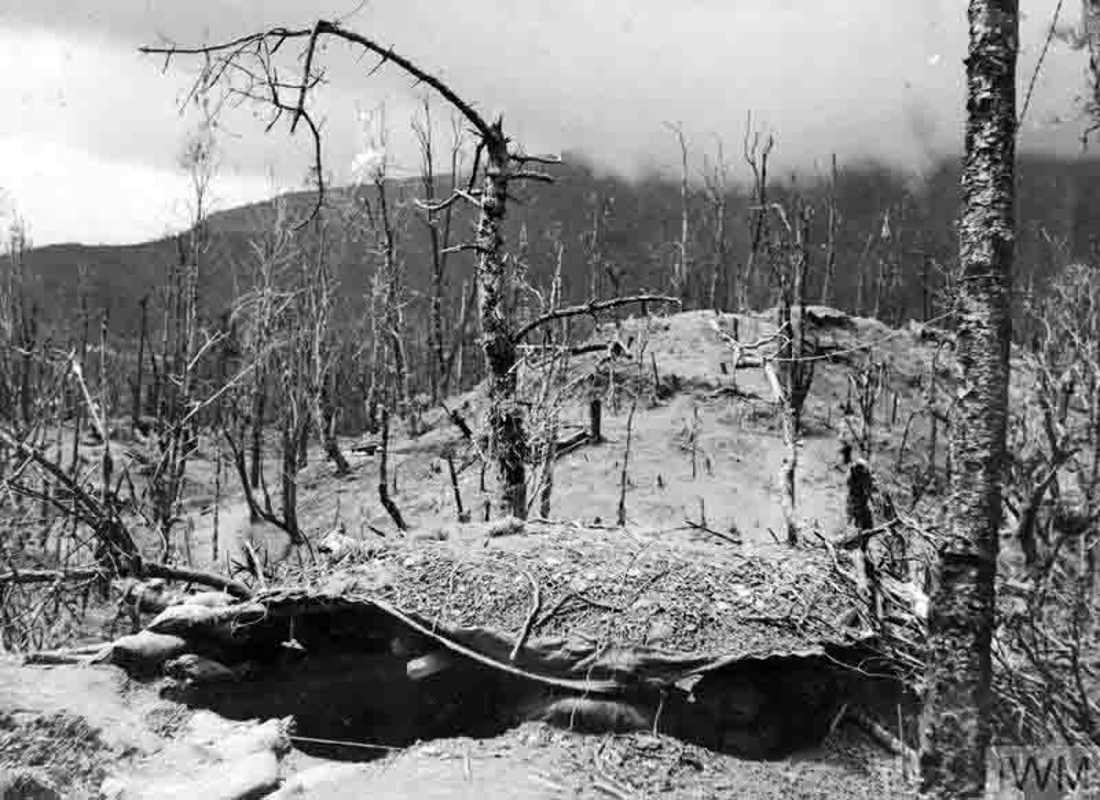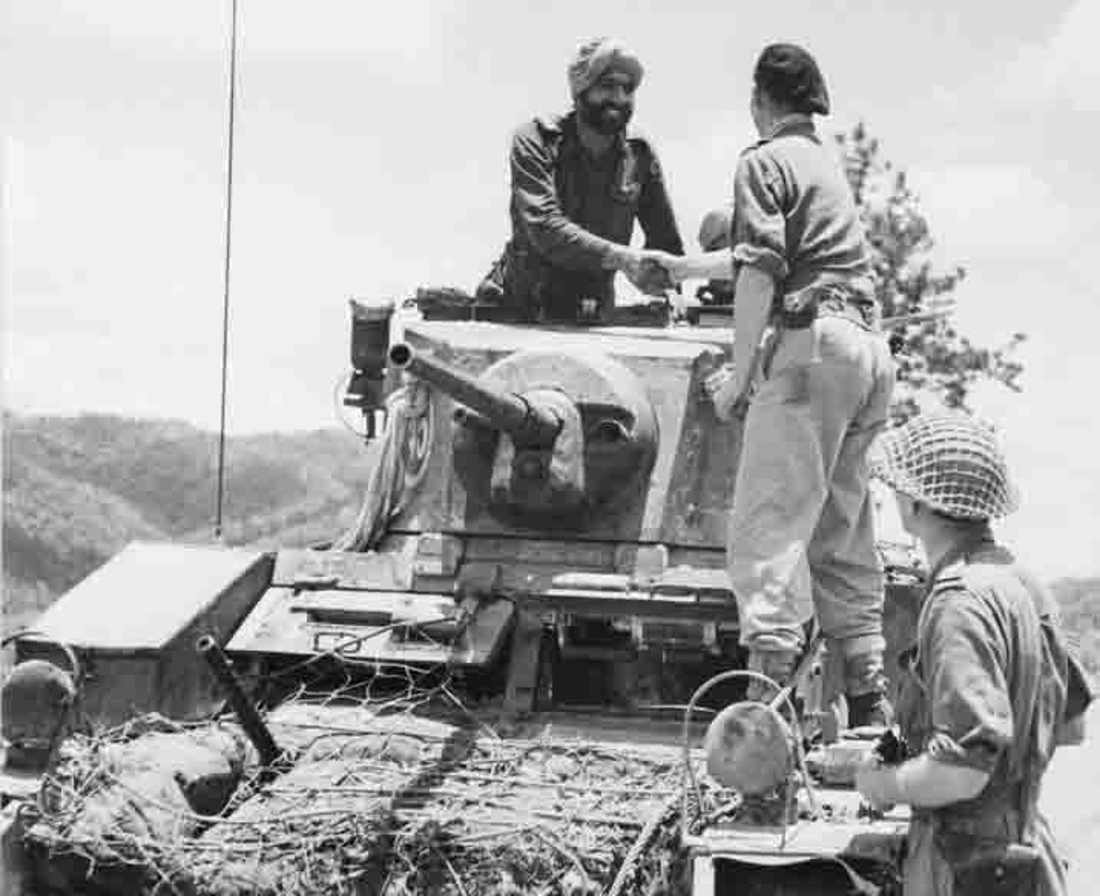
The Battles of Imphal and Kohima

British soldiers search for Japanese snipers while covered by a Bren gun team.
On 7 December 1941, the forces of Imperial Japan launched surprise attacks throughout the Far East and the Pacific. Just two weeks later Commonwealth forces in Hong Kong surrendered, and by March 1942, Singapore and Rangoon had fallen.
Defeated, the surviving Commonwealth troops in Burma withdrew over 1,000 miles through the mountainous Burmese jungles from Rangoon to India, the longest retreat in British military history.
The Fourteenth Army

An Indian infantry section of the 2nd Battalion, 7th Rajput Regiment about to go on patrol.
By winter 1942, what remained of the Commonwealth army in the Far East was recovering in the north-eastern Indian provinces of Nagaland and Manipur, on the border with Burma. Morale was low but their enigmatic commander, General William Slim, was undeterred. He set about regrouping, retraining and resupplying his men, intending to return to Burma at the earliest opportunity.
In 1943, Slim’s force was renamed the Fourteenth Army. It was one of the most diverse in history, with African, Indian, Gurkha and British formations. Soldiers from the Gold Coast and Sierra Leone, Uganda and Kenya, worked alongside those from across undivided India, and the United Kingdom. Over the next two years they trained tirelessly to become a formidable fighting force, specialising in jungle warfare.
The Chindits

Chindit unit crossing a river with mules, essential for carrying supplies in the Burma campaign.
With the bulk of Commonwealth forces regrouping, two special operations were undertaken in Burma. In February 1943, led by their unconventional commander Orde Wingate, 3,000 soldiers of the Long Range Penetration Group, better known as the Chindits, fought deep behind enemy lines for three months. Resupplied from the air, they attacked enemy bases, destroyed railways and generally frustrated the Japanese.
The operation had a remarkable morale value for the rest of the Fourteenth Army, proving that the Japanese could be beaten at jungle warfare. But casualties were heavy, and over half the Chindit force was lost or considered unfit for any future service. Many who died have no known grave and are commemorated on the CWGC Rangoon Memorial.

West African troops board an aircraft before Operation Thursday, March 1944.
Despite the losses, a second much larger operation was undertaken: Operation Thursday. In February 1944, more than 9,000 Chindits were airlifted deep into Burma. They would become a thorn in the side of the Japanese during their forthcoming offensive.
Operation U-Go and the Invasion of India
The Japanese were well aware of the Commonwealth and Allied forces gaining strength in India and China. Intending to destroy the threat, the Japanese launched Operation U-Go, the invasion of India. After fierce clashes on the border in February 1944, the main Japanese force, 85,000 strong, crossed the Chindwin River on 8 March and poured into India.
The Battle of Imphal

Members of the RAF Regiment point out Japanese positions in the Imphal Valley.
By April, the Japanese had reached Imphal. The town lies on a vast plain, surrounded by mountains and jungle, and here the bulk of the Fourteenth Army made their stand. The Japanese moved quickly to surround the defenders but, unlike in previous clashes, the Commonwealth troops battled on, resupplied from the air. The fighting was brutal and confused, and groups of men could be completely isolated for days, fighting for survival.
The Battle of Kohima

The mined tennis court and terraces of the District Commissioner's bungalow in Kohima.
60 miles north of Imphal, a small Commonwealth garrison held the town of Kohima, at the highest point of the pass through the impenetrable mountain jungles to Dimapur. If Kohima fell, Dimapur would follow, and the vital supplies for the defenders of Imphal would cease.
On 3 April, a Japanese force of 15,000 attacked Kohima.
Of the 2,500-strong garrison at Kohima, only half were combat troops. Pushed back in desperate and bloody fighting, they held out on Kohima Ridge. Before the war, the British Deputy Commissioner had lived here, and his house and tennis court became the scene of a brutal hand-to-hand struggle. The once-peaceful ridge was transformed into a wasteland of blasted tree stumps and shell holes.
After two weeks of constant fighting the garrison held only 350 square metres of ground near the tennis court, and the situation was desperate. Few Commonwealth soldiers remained unwounded, many were almost starving, and all were severely dehydrated. The end seemed near.
Victory at Kohima

A British position on Garrison Hill, overlooking Kuki Piquet, Kohima, June 1944.
At dawn on 18 April, the exhausted Kohima garrison prepared to make their last stand. In the enemy trenches just a few metres away they could hear the Japanese massing for their final attack. At that moment shells began falling on the Japanese positions and tanks of the relieving force could be seen arriving. The garrison was saved from annihilation and Kohima was secured.
The Japanese, however, were far from defeated, and they fought bitterly to hold the many ridges and hills surrounding Kohima. After four weeks the Japanese soldiers were starving and they were finally forced to withdraw in mid-May. The Battle of Kohima was over.
Victory at Imphal

Imphal to Kohima: Jemader Karnail Singh of 7th Cavalry shakes hands with 33 Corps Major AC T Brotherton.
With the road to Dimapur secured, the defenders of Imphal linked up with reinforcements advancing from Kohima on 22 June.
Under constant air attack and with their supply lines mercilessly assaulted by Chindit forces and air strikes, the last Japanese attacks at Imphal launched in late June had no success.
On 3 July, after nearly five months of fighting, the surviving Japanese forces fell back. More than 8,000 Commonwealth servicemen were wounded, killed or missing, but of the 85,000 strong Japanese force that had crossed the Chindwin River in March, less than a third returned. The battles had been fierce, but it was starvation and disease that had caused most of the Japanese losses. It was by far the worst Japanese land defeat of the war to that date.

Men of the Devonshire Regiment autograph Japanese flags captured at Nippon Ridge during the Battle of Imphal-Kohima.

Leave your own Legacy
A gift in your will can help us continue telling those stories for generations to come, so their sacrifice is not forgotten.

SHARE THE STORIES OF KOHIMA AND IMPHAL
Find out more about some of the people involved in these pivotal moments in the Burma Campaign. Visit For Evermore: Stories of the Fallen, our online commemorative resource to read and share their fascinating stories.
All images © IWM unless otherwise indicated.

